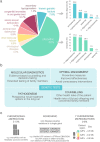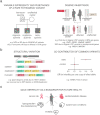Translational aspects of novel findings in genetics of male infertility-status quo 2021
- PMID: 34755838
- PMCID: PMC8677437
- DOI: 10.1093/bmb/ldab025
Translational aspects of novel findings in genetics of male infertility-status quo 2021
Abstract
Introduction: Male factor infertility concerns 7-10% of men and among these 40-60% remain unexplained.
Sources of data: This review is based on recent published literature regarding the genetic causes of male infertility.
Areas of agreement: Screening for karyotype abnormalities, biallelic pathogenic variants in the CFTR gene and Y-chromosomal microdeletions have been routine in andrology practice for >20 years, explaining ~10% of infertility cases. Rare specific conditions, such as congenital hypogonadotropic hypogonadism, disorders of sex development and defects of sperm morphology and motility, are caused by pathogenic variants in recurrently affected genes, which facilitate high diagnostic yield (40-60%) of targeted gene panel-based testing.
Areas of controversy: Progress in mapping monogenic causes of quantitative spermatogenic failure, the major form of male infertility, has been slower. No 'recurrently' mutated key gene has been identified and worldwide, a few hundred patients in total have been assigned a possible monogenic cause.
Growing points: Given the high genetic heterogeneity, an optimal approach to screen for heterogenous genetic causes of spermatogenic failure is sequencing exomes or in perspective, genomes. Clinical guidelines developed by multidisciplinary experts are needed for smooth integration of expanded molecular diagnostics in the routine management of infertile men.
Areas timely for developing research: Di-/oligogenic causes, structural and common variants implicated in multifactorial inheritance may explain the 'hidden' genetic factors. It is also critical to understand how the recently identified diverse genetic factors of infertility link to general male health concerns across lifespan and how the clinical assessment could benefit from this knowledge.
Keywords: Klinefelter syndrome; Y-chromosomal microdeletion; andro-exome pipeline; assisted reproductive technology (ART); azoospermia; chronic disease; clinical guidelines; congenital absence of vas deference; congenital hypogonadotropic hypogonadism; diagnostic gene panel; disorders of sex development; exomes; genetic cause; genetic counselling; genetics; globozoospermia; male infertility; molecular diagnostics; multiple morphological abnormalities of the sperm flagella; oligogenic inheritance; pathogenic variant; pleiotropic genes; severe oligozoospermia; spermatogenic failure; testicular sperm extraction (TESE); translational research.
© The Author(s) 2021. Published by Oxford University Press. All rights reserved. For Permissions, please email: journals.permissions@oup.com.
Figures


References
-
- Jungwirth A, Giwercman A, Tournaye H, et al. European Association of Urology guidelines on male infertility: the 2012 update. Eur Urol 2012;62:324–32. - PubMed
-
- Schlegel PN, Sigman M, Collura B, et al. Diagnosis and treatment of infertility in men: AUA/ASRM guideline part I. Fertil Steril 2021;115:54–61. - PubMed
-
- Agarwal A, Baskaran S, Parekh N, et al. Male infertility. Lancet 2021;397:319–33. - PubMed
-
- Olesen IA, Andersson A-M, Aksglaede L, et al. Clinical, genetic, biochemical, and testicular biopsy findings among 1,213 men evaluated for infertility. Fertil Steril 2017;107:74–82.e7. - PubMed
Publication types
MeSH terms
LinkOut - more resources
Full Text Sources
Medical
Research Materials

